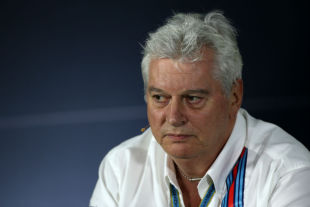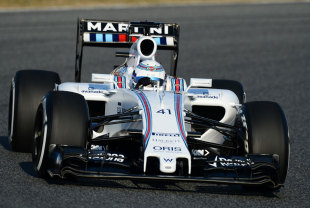
- Interview with Pat Symonds
Symonds: McLaren couldn't win as a customer, Williams can
Nate Saunders March 7, 2015ESPN sat down with Williams chief technical officer Pat Symonds to talk about the design challenges of the 2015 Williams, the team's relationship with Mercedes and even his thoughts on McLaren CEO Ron Dennis...

How much of a challenge have the new front noses been from an aerodynamic perspective in terms of retaining that performance from the front?
It's been significant actually. It's one of those things where a set of rules were written for 2014 and when we got into the details there were, I call them loopholes. It produced a result aesthetically that wasn't what people had in mind when the rules were written and it's often the case because when you write the rules you're thinking 'what is the thing going to look like?'. Then of course when you get down to the detail and other people who are doing it on a daily basis looking at a geometry they see ways around it. For 2015 the idea was to tidy things up and get a little closer to what was intended in 2014. I think we were all a little bit guilty of saying 'Ok, that's a lot tidier, that'll be OK', but when we actually did we thought, 'Jesus, this has lost a bit of downforce!' so there's been a fair lot of work in that area. I think one of the difficulties is it became obvious with a nose that low that you wanted to keep it relatively short. That becomes quite a challenge on the crash test.
I was going to mention crash test. It's all about finding sufficient space and structure?
That's the real compromise - how short can you go and yet still get through the crash test. There's still a few variations on the confidence of getting through the crash tests out there, definitely.
Last year with the new noses, was it the case that actually the impact on them, because of the way you can design them, wasn't that huge?
Yes, that's true. But there were a lot of other changes as well. Isolating them out was not so obvious as it was this year where it was really just a single change and we went, 'OK'. There was a lot of work around the front end, understanding what we needed to do with the lower nose, and then at the back end of our car, because we'd identified there were certainly some limitations there we really started straight from the beginning with a different philosophy of lowering the lower wishbones to improve the flow around there. That then rewarded the central pillar wing which we hadn't found rewarded before because we were then able to alter the rear wing end plates. Nothing is in isolation, it's all part of a philosophy and that philosophy works quite well.
Have there been any significant changes in terms of how you are able to package the Mercedes PU?
No, not huge. Obviously what we've had to deal with a little more this year is the plenums are bigger this year because of the variable trumpets. The exhaust system this year is a little bit bigger. Nothing has affected our packaging much and I certainly don't think it's affected our aerodynamics.
Last year Williams were bringing a huge amount of new parts to the car every weekend. Is that something you are hoping to do again this year?

I think it's something you've just got to do these days. Even Mercedes, who are clearly ahead at the moment, will still be doing that because if they don't they'll get caught. Last year we got closer to them, we didn't catch them, but we got closer to them by having that very good development rate and that's part of modern Formula One. So we'll be carrying on and the rate of which we bring them will be the rate at which we can invent and that's one thing you can't schedule.
You mentioned your rate of development. With the restrictions in place on tunnel time and CFD, have you had to find more effective and efficient ways of getting things through development process?
Absolutely. If you go back to sort of 2008 or so when there was no focus on it, tunnels just ran 24/7, no concerns about anything. You look back now at what we were doing then and it's shocking, I mean really shocking, how inefficient we were. Then of course the FOTA restrictions came in. They weren't very draconian to start with but they made us start looking at efficiency. Now they're hard, they really are hard. There's a very, very significant change in the amount of time we can spend developing the aerodynamics so of course it pushes us to more efficiency. But it still has had a very positive and profound effect because not only has it cut down on the whole aerodynamics group, it's cut down on running the tunnels which are incredibly expensive to run. You're talking £1 million a year just for electricity before anything else, and you're running 24/7.
The good thing is what you're doing is you're stemming the flow where the leak starts, if you like. By reducing the amount of time spent on aerodynamic development further down the line you're reducing the amount that you spend on components so I think it's actually been very effective. To me it's much more the way I like to do engineering. It's actually been very effective. It's driven efficiency, it has driven cost saving and for me it's much more the way I like to do engineering. I think there was an awful lot of the scatter gun approach in the old days. Now I really encourage the guys to stop and think and understand. I think I got a very good lesson in that when I was doing that work for Marussia because we were in the wind tunnel for two shifts, five days, every month and that focuses your mind on getting results and understanding what's going on. So that was a good little lesson for me.
Did the ban on Front and Rear Interconnected (FRIC) suspension lead to a major change in design for this year's car?
Not as such. The interconnect used on the Williams was quite a simple system; certainly I was surprised when I arrived how simple it was. Having been involved in the original one at what was then Renault and then having developed it significantly further at Marussia, I was surprised that it was a really basic device. On top of that, with aerodynamics we weren't as rewarded by the interconnect as I believe other cars were. So taking it off wasn't a really big deal for us because we didn't lose a lot of performance. We had to lift ride height but we didn't have a lot of ride height to begin with. That isn't to say we haven't looked quite carefully at suspension geometry this year - one of the complaints of the drivers last year was coming out of corners we had combined lateral and traction events going on. I certainly felt there were things that could be done with suspension to improve that and over winter they have reported a big improvement on that.
As a customer, what is the feedback you get from Mercedes? Surely they are working on a lot of things specific to their package.

It's not particularly specific. Because all the hardware has to be the same all the base mapping will be very similar. There might be a little bit of individual tuning we do for our own cars but I'm very happy with the way we work with them.
Before McLaren switched to Honda power last year, Ron Dennis said it is impossible for a customer team to win the world championship. Do you agree with that?
Well, when he was the works Mercedes team he got beaten by Brawn, didn't he? Maybe it's just difficult for him to win. Just like it's difficult for him to find title sponsors.
Nate is assistant editor of ESPNF1
